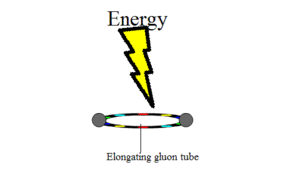Color confinement


Color confinement, often simply called confinement, is the phenomenon that color charged particles (such as quarks) cannot be isolated singularly, and therefore cannot be directly observed.[1][2] Quarks, by default, clump together to form groups, or hadrons. The two types of hadrons are the mesons (one quark, one antiquark) and the baryons (three quarks).
The constituent quarks in a group cannot be separated from their parent hadron, and this is why quarks currently cannot be studied or observed in any more direct way than at a hadron level.[3]
Origin
The reasons for quark confinement are somewhat complicated; no analytic proof exists that quantum chromodynamics should be confining. The current theory is that confinement is due to the force-carrying gluons having color charge. As any two electrically charged particles separate, the electric fields between them diminish quickly, allowing (for example) electrons to become unbound from atomic nuclei. However, as a quark-antiquark pair separates, the gluon field forms a narrow tube (or string) of color field between them. This is quite different from the behavior of the electric field of a pair of positive and negative electric charges, which extends into the whole surrounding space and diminishes at large distances. Because of this behavior of the gluon field, a strong force between the quark pair acts constantly—regardless of their distance[4][5]—with a force of around 10,000 newtons.[6]
When two quarks become separated, as happens in particle accelerator collisions, at some point it is more energetically favorable for a new quark–antiquark pair to spontaneously appear, than to allow the tube to extend further. As a result of this, when quarks are produced in particle accelerators, instead of seeing the individual quarks in detectors, scientists see "jets" of many color-neutral particles (mesons and baryons), clustered together. This process is called hadronization, fragmentation, or string breaking, and is one of the least understood processes in particle physics.
The confining phase is usually defined by the behavior of the action of the Wilson loop, which is simply the path in spacetime traced out by a quark–antiquark pair created at one point and annihilated at another point. In a non-confining theory, the action of such a loop is proportional to its perimeter. However, in a confining theory, the action of the loop is instead proportional to its area. Since the area will be proportional to the separation of the quark–antiquark pair, free quarks are suppressed. Mesons are allowed in such a picture, since a loop containing another loop in the opposite direction will have only a small area between the two loops.
Models exhibiting confinement
Besides QCD in four spacetime dimensions, another model which exhibits confinement is the Schwinger model.[7] Compact Abelian gauge theories also exhibit confinement in 2 and 3 spacetime dimensions.[8] Confinement has recently been found in elementary excitations of magnetic systems called spinons.[9]
Models of fully screened quarks
Besides the quark confinement idea, there is a potential possibility that the color charge of quarks gets fully screened by the gluonic color surrounding the quark. Exact solutions of SU(3) classical Yang–Mills theory which provide full screening (by gluon fields) of the color charge of a quark have been found.[10] However, such classical solutions do not take into account non-trivial properties of QCD vacuum. Therefore, the significance of such full gluonic screening solutions for a separated quark is not clear.
See also
- Gluon field strength tensor
- Asymptotic freedom
- Center vortices
- Deconfining phase
- Quantum mechanics
- Particle physics
- Fundamental force
- Dual superconducting model
- Beta-function
- Infrared safety
References
- ↑ V. Barger, R. Phillips (1997). Collider Physics. Addison–Wesley. ISBN 0-201-14945-1.
- ↑ J. Greensite (2011). An introduction to the confinement problem. Springer. ISBN 978-3-642-14381-6.
- ↑ T.-Y. Wu, W.-Y. Pauchy Hwang (1991). Relativistic quantum mechanics and quantum fields. World Scientific. p. 321. ISBN 981-02-0608-9.
- ↑ T. Muta (2009). Foundations of quantum chromodynamics: an introduction to perturbative methods in gauge theories (3rd ed.). World Scientific. ISBN 978-981-279-353-9.
- ↑ A. Smilga (2001). Lectures on quantum chromodynamics. World Scientific. ISBN 978-981-02-4331-9.
- ↑ Fritzsch, op. cite, p. 164. The author states that the force between differently coloured quarks remains constant at any distance after they travel only a tiny distance from each other, and is equal to that need to raise one ton, which is 1000 kg x 9.8 m/s^2 = ~10,000 N.
- ↑ Wilson, Kenneth G. (1974-10-15). "Confinement of Quarks". Physical Review D. College Park, MD, USA: American Physical Society. 10: 2445–2459. Bibcode:1974PhRvD..10.2445W. doi:10.1103/PhysRevD.10.2445. ISSN 1550-2368. OCLC 55589778. Retrieved 2014-04-12.
- ↑ Schön, Verena; Michael, Thies (2000-08-22). "2d Model Field Theories at Finite Temperature and Density (Section 2.5)". arXiv:hep-th/0008175v1
 [hep-th].
[hep-th]. - ↑
 Lake, Bella; Tsvelik, Alexei M.; Notbohm, Susanne; Tennant, D. Alan; Perring, Toby G.; Reehuis, Manfred; Sekar, Chinnathambi; Krabbes, Gernot; Büchner, Bernd (2009-11-29). "Confinement of fractional quantum number particles in a condensed-matter system". Nature Physics. London, UK: Nature Publishing Group. 6 (1): 50–55. arXiv:0908.1038
Lake, Bella; Tsvelik, Alexei M.; Notbohm, Susanne; Tennant, D. Alan; Perring, Toby G.; Reehuis, Manfred; Sekar, Chinnathambi; Krabbes, Gernot; Büchner, Bernd (2009-11-29). "Confinement of fractional quantum number particles in a condensed-matter system". Nature Physics. London, UK: Nature Publishing Group. 6 (1): 50–55. arXiv:0908.1038 . Bibcode:2010NatPh...6...50L. doi:10.1038/nphys1462. ISSN 1745-2481. OCLC 150143123. Retrieved 2014-04-12. (subscription required (help)).
. Bibcode:2010NatPh...6...50L. doi:10.1038/nphys1462. ISSN 1745-2481. OCLC 150143123. Retrieved 2014-04-12. (subscription required (help)). - ↑
 Cahill, Kevin (1978-08-28). "Example of Color Screening". Physical Review Letters. American Physical Society. 41 (9): 599–601. Bibcode:1978PhRvL..41..599C. doi:10.1103/PhysRevLett.41.599. ISSN 1079-7114. OCLC 31492939. Retrieved 2014-04-12. (subscription required (help)).
Cahill, Kevin (1978-08-28). "Example of Color Screening". Physical Review Letters. American Physical Society. 41 (9): 599–601. Bibcode:1978PhRvL..41..599C. doi:10.1103/PhysRevLett.41.599. ISSN 1079-7114. OCLC 31492939. Retrieved 2014-04-12. (subscription required (help)).